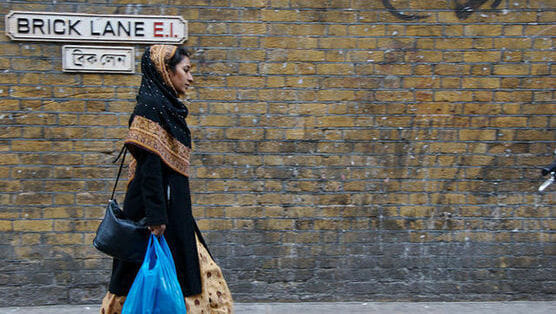Brick Lane by Monica Ali

Almost 14 months after the collapse of the Rana Plaza building in Dhaka, Bangladesh, the debate surrounding the global garment factory industry shows no sign of abating.
The April 24, 2013, collapse killed more than 1,100 people and injured more than 2,500—making it the world’s worst industrial structure failure. Most victims were women. Most were poor. I happened to be nearby that day, but I kept a respectful distance. The rescue workers didn’t need a white guy poking his nose into the nation’s rubble.
Recently, American Apparel’s controversial “Made in Bangladesh” campaign stoked the debate about working conditions in the nation. Ads show a bare-breasted girl—Maks is her name—as the embodiment of modern Bangladeshi feminism. The campaign generated praise and condemnation in equal measure around the world. If nothing else, it reminded media that Bangladesh still exists.
Similarly, the BBC produced an exposé-style documentary from Bangladesh earlier this year, reminding viewers how the abuse and exploitation of young and vulnerable girls continue in seedy garment factories. These sweatshops produce 60 percent of Europe’s apparel exports and 40 percent of America’s. Such media attention does nothing to improve the reputation of Bangladesh.
I couldn’t help but consider all of this as I read Monica Ali’s award-winning debut novel Brick Lane. Set on and around the events of 9/11, Brick Lane primarily focuses on life in Britain for Nazneen, the protagonist. This poor, non-English-speaking Muslim Bangladeshi girl has been brought to Britain for an arranged marriage.
We see this young girl coping with a world far removed from her village upbringing in Asia. She grows into a woman through trials, the death of her firstborn and the failures of her husband. All the while, she remains faithfully in contact with her sister in Bangladesh and watches silently as the Muslim youth in London increasingly agitate towards political violence. One of these youths grabs Nazneen’s attention and ultimately her heart.
Ali, the author, knows her subject matter. She herself left what was then East Pakistan at age three and moved to the United Kingdom.
By contrast, I have only ever known rural Bangladesh. (I lived there for six years, returning to the U.K. just recently.) Also, as a white middle-class male, I know little of life for Asians in the West. By all odds, I should identify with a protagonist like Nazneen, living in a Britain I know intimately.
Yet, I identified most with another character. Nazneen’s sister, Hasina, never leaves Bangladesh at all in the novel. Through letters scattered through the story, Hasina describes her life working in a garment factory in Dhaka. I found Ali’s interpretation ringing true from my own experiences and from what I learned in friendships with women throughout the country. The sister’s letters come across as genuine for me, and powerful.
Only when Nazneen begins her own garment work—she sews on a machine in her home in London—did I began to relate to this character. Most of the novel, incidentally, takes place around Nazneen in Tower Hamlets, a squalid setting where toilets always run and gangs of youths run too, taking drugs and fighting in post-Thatcher Britain.
Nazneen looks after Chanu, her incompetent husband, and two daughters. By sewing, she earns money to pay for an ill-advised loan taken out by Chanu. She also manages to send a little money back to her sister.
-

-

-

-

-

-

-

-

-

-

-

-

-

-

-

-

-

-

-

-

-

-

-

-

-

-

-

-

-

-

-

-

-

-

-

-

-

-

-

-








































